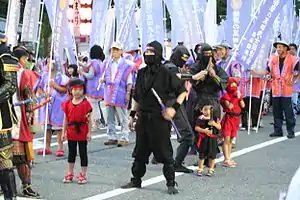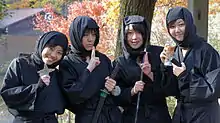Ninjas in popular culture
Ninjas are historically known as Japanese spies, assassins, or thieves who formed their own caste outside the usual feudal divisions of lords, and samurai serfs. They are often used as stock characters, in Japanese popular culture and global popular culture.

History

The ninja first entered popular culture in the Edo period. In modern Japan, ninjas are a national myth that stems from folk tales and continues through modern day popular culture.[1] Though many Japanese warriors performed amazing feats, there is no evidence that any of them were supernatural. Some of folk tales are based on historical figures, such as a daimyō (lord) challenging a ninja to prove his worth by stealing his pillow or weapon while he slept.[2]:14
Ninja-themed international media franchises include the Teenage Mutant Ninja Turtles, and the Naruto manga and anime series.[3][4]
Legendary abilities
Superhuman or supernatural powers were sometimes associated with the ninja. Such powers include flight, invisibility, shapeshifting, the ability to "split" into multiple bodies, the summoning of animals, and control over the five classical elements. These notions stemmed from popular imagination regarding the ninja's mysterious status, as well as romantic ideas found in later Japanese art during the Edo period. Magical powers were sometimes rooted in the ninja's own efforts to disseminate fanciful information. For example, Nakagawa Shoshujin, the 17th-century founder of Nakagawa-ryū, or martial art style, claimed in his own writings (Okufuji Monogatari) that he had the ability to transform into birds and animals.[2]:13
Perceived control over the elements may be grounded in real tactics, which were categorized by association with forces of nature. For example, the practice of starting fires in order to cover a ninja's trail falls under katon-no-jutsu ("fire techniques").[5]
The ninja's adaption of kites in espionage and warfare is another subject of legends. Accounts exist of ninjas being lifted into the air by kites, where they flew over hostile terrain and descended into or dropped bombs on enemy territory.[6] Kites were indeed used in Japanese warfare, but mostly for the purpose of sending messages and relaying signals.[7]:257 Turnbull suggests that kites lifting a man into midair might have been technically feasible, but states that the use of kites to form a human "hang glider" falls squarely in the realm of fantasy.[2]:22–23
Kuji-kiri
Kuji-kiri is an esoteric religious practice which, when performed with an array of specified hand "seals" (kuji-in), or gestures, was meant to allow the ninja to interact with the spirit world and allow them to perform superhuman feats.
The kuji ("nine characters") is a concept originating from Taoism, where it was a string of nine words used in charms and incantations.[8]:2–3 In China, this tradition mixed with Buddhist beliefs, assigning each of the nine words to a Buddhist deity. The kuji may have arrived in Japan via Buddhism,8-11}} where it flourished within Shugendō.[8]:13 Here too, each word in the kuji was associated with Buddhist deities, animals from Taoist mythology, and later, Shinto kami.[8]:24–27 The mudrā, a series of hand symbols representing different Buddhas, was applied to the kuji by Buddhists, possibly through the esoteric Mikkyō teachings.[8]:24–25 The yamabushi ascetics of Shugendō adopted this practice, using the hand gestures in spiritual, healing, and exorcism rituals.[9]
Later, the use of kuji passed onto certain bujutsu (martial arts) and ninjutsu schools, where it was said to have many purposes.[8]:31–33 The application of kuji to produce a desired effect was called "cutting" (kiri) the kuji. Intended effects range from physical and mental concentration, to more incredible claims about rendering an opponent immobile, or even the casting of magical spells.[8]:31 These legends were captured in popular culture, which interpreted the kuji-kiri as a precursor to magical acts.
1998 East Java ninja scare
The 1998 East Java ninja scare was an outbreak of mass hysteria in East Java, Indonesia, in which the local population believed they were being targeted by sorcerers known as ninja, who were blamed for mysterious killings of religious leaders by assassins dressed in black. As many as 150-300 “sorcerers” were killed between February and October, with the most deaths occurring between August and September.[10]
Armed groups
Several real life paramilitary, police and militia groups use the names "Ninja" or "Ninjas":
- The Santomean special-police force of the Democratic Republic of São Tomé and Príncipe, officially known as the Emergency Police, are popularly known as Ninjas.[11]
- Rebels in the Pool Region of the Republic of the Congo called themselves Ninja.[12]
- The Red Berets, a Croatian Serb rebel paramilitary group of Dragan Vasiljković based in Knin, Croatia, called themselves "Kninjas".[13] During the early 1990s, the Kninjas were the subject of a Serbian comic-book series.[14][15]
- Although some death squads active during the Indonesian occupation of East Timor called themselves "Ninja", the name was apparently borrowed from film rather than the Japanese model.[16] "Ninja" gangs were also active elsewhere in Indonesia.[17]
- During the Algerian Civil War, the government's commando units were known as "Ninja" because of their black hoods.[18]
- The FBI's Hostage Rescue Team have been nicknamed "Ninjas".[19]
Other
According to Indeed.com, there was a 7,000-percent increase in the number of job listings with the word "ninja" from 2006 to 2012.[20] A former Russian soldier who committed robberies in Italy in black attire and a bow was called a "Russian ninja" by the BBC.[21] The video-game series Tenchu was adapted for the Japanese stage.[22] In 2006, Miss Japan Kurara Chibana appeared in a ninja-samurai costume for the Miss Universe competition.[23] Goth Ninja, a type of Japanese street fashion, became popular in 2009.[24]
In information technology, "cyber ninja" are sophisticated counter-hackers.[25]
Business


Iga Ueno Ninja Festa, the annual ninja festival in Iga in the former province of Iga, has had ninja-inspired performances, competitions and opportunities to practice ninja skills since 1964.[26]
Attractions
Other ninja attractions in Japan include the Koga Ninja Village and Kogaryu Ninjutsu Yashiki (Ninja Houses) in Koga-gun, Shiga Prefecture, the Togakushi Ninja Village for children, the Togakushi Ninpo Museum and Karakuri Yashiki (Ninja House) in Togakushi, Nagano, the Edo Wonderland theme park in Nikkō, Tochigi and the restaurants Men no Sato and Ninja Akasaka in Tokyo and Ninja Kyoto in Kyoto.[1]
Examples
Anime and manga

- Black Lion (Kuro no Shishi): Manga series.[27]
- Brave10: Manga adaptation of Sanada Ten Braves.[28]
- Kunoichi Hajimemashita!: Gag manga series.[29]
- Naruto: Manga and anime series.[4]
- The Last Kunoichi (Kunoichi Bakumatsu Kitan): Erotic anime series about kunoichi caught in the struggles of the late Tokugawa shogunate.[30]
- Sarutobi Sasuke: Manga by Shigeru Sugiura.[31]
- Sasuga no Sarutobi: TV series and comedy manga by Fujihiko Hosono about a ninja high school.[32]
- Shōnen Jiraiya: manga by Shigeru Sugiura.[31]
- Tenshi wa Maiorita - Kunoichi Ibun: Historical manga series by Ryoichi Ikegami.[33]
- Zannen Kunoichi Den: manga series.[34]
The following stories contain a ninja character, but are not ninja-themed:
- Millennium Actress.[35]
- Sailor Victory: Comedy OAV series about a team of policewomen using ninja robots.[36]
- Planetes (Tanabe's neighbors in "The Lunar Flying Squirrels").[37]
- Tower of Etruria (Palmyra).[38]
Film
Video games
In addition to video games, several game-development companies use "ninja" in their name: Ninja Studio, Ninja Theory, Ninjaforce, NinjaKiwi, and Team Ninja. In massively multiplayer online role-playing games (MMORPGs), "ninja", "loot ninja" or "ninja looter" pejoratively describes a player who has stolen something from another player.
Traditional games
- Magic: The Gathering (where the ability Ninjutsu was introduced in the set Betrayers of Kamigawa).[39]
Novels
Ninja-themed novels include:
- Tulku, a Tale of Modern Ninja: novel by American ninjutsu practitioner Stephen K. Hayes.[40]
- Tsuma-wa, Kunoichi: historical novel.[41]
- Vineland.[42]
Non-Japanese comics

- The Justice League: Shogun of Steel one-shot substitutes Batman with a Japanese female ninja named Komori (Bat).[43]
- Half Past Danger.[44]
- Zombee.[45]
- G.I. Joe: A Real American Hero characters Storm Shadow and Snake-Eyes, and their family history, as well as Jinx and Cobra Night Creepers and Red Ninjas.
Music
- Ninja Crew.[46]
- "Inner Ninja" by Classified (on Classified).[47]
- Built by Ninjas is a music video production group formed by Jaret Reddick and Heath Balderston.[48][49]
- Fans of the rap group Insane Clown Posse, known as juggalos, sometimes refer to themselves as "ninja".[50]
- Members of Momoiro Clover Z dressed as ninja for the music video for "D' no Junjō".[51]
- Rika Adachi performed in a music video based on a song from Naruto.[52]
Sports
- Iga FC Kunoichi is a Japanese Nadeshiko League women's association football team.[53]
- Ninja Chops wrestles in the Naked Women's Wrestling League.[54]
Series
- Samurai Girl (2008).[55]
- Tsuma-wa, Kunoichi (2014-2015).[56][57]
- Batman Beyond (Curaré of the League of Assassins).[58]
- Black Dynamite ("Just Beat It or Jackson Five Across Yo' Eyes").[59]
- Stroker and Hoop ("Ninja Worrier" and "Chopping Spree").[60]
- Honda Civic Si.[61]
- G.I. Joe: A Real American Hero. Appearances by Storm Shadow, a ninja working for Cobra.
See also
References
- Phelan, Stephen (2015-06-05). "Tall tales and tiny assassins at Japan's ninja festival". The Guardian. Retrieved 2011-02-26.
- Stephen Turnbull (2003). Ninja, A.D. 1460-1650. Bloomsbury Publishing. ISBN 9781841765259.
- McNeil, Jason William. "Return of the Ninja!". Black Belt. Archived from the original on November 17, 2009. Retrieved June 30, 2010.
- Hendrix, Grady (2007-06-26). "The state of the ninja". Slate. Retrieved 2015-06-05.
- Mol, Serge (2003). Classical Weaponry of Japan: Special Weapons and Tactics of the Martial Arts (1st ed.). Tokyo: Kodansha International. p. 176. ISBN 9784770029416.
- Draeger, Donn F.; Smith, Robert W. (1985). Comprehensive Asian Fighting Arts (1st ed.). Tokyo: Kodansha International. pp. 128–129. ISBN 9780870114366.
- Buckley, Sandra (2001). Encyclopedia of Contemporary Japanese Culture (1st ed.). New York: Routledge. ISBN 9780415143448.
- Waterhouse, David (1996). Religion in Japan: Arrows to Heaven and Earth (Reprint ed.). Cambridge: Cambridge University Press. ISBN 9780521550284.
- Teeuwen, Mark; Rambelli, Fabio (2003). Buddhas and Kami in Japan: Honji Suijaku as a Combinatory Paradigm. London: Routledge Curzon. p. 327. ISBN 9780415297479.
- Kristof, Nicholas D. (October 20, 1998). "Fears of Sorcerers Spur Killings in Java". The New York Times. Retrieved June 6, 2018.
- "Elite "Ninja" police free hostages in Sao Tome". Reuters AlertNet. October 10, 2007. Archived from the original on November 9, 2008. Retrieved August 26, 2009.
- Tsoumou, Christian (June 8, 2007). "Congo's Ninja rebels burn weapons and pledge peace". Reuters AlertNet. Archived from the original on August 4, 2009. Retrieved August 26, 2009.
- Robinson, Natasha; Madden, James (April 13, 2007), Captain Dragan set for extradition, The Australian, archived from the original on August 4, 2009, retrieved August 26, 2009
- Knight-Ridder Newspapers (1991-12-25). "Serbian Media Bombard Public With Nazi Footage, 'Kninjas'". The Seattle Times. Retrieved 2013-08-04.
- Borman, Trevor (May 27, 2011). "The Real Captain Dragan". ABC News. Archived from the original on December 25, 2012. Retrieved August 5, 2013.
- Lane, Max (March 1, 1995). "'Ninja' terror in East Timor". Green Left Weekly. Archived from the original on August 4, 2009. Retrieved August 26, 2009.
- "Indonesia's 'ninja' war". BBC News. October 24, 2008. Retrieved August 6, 2009.
- Dickey, Christopher (June 18, 1995). "The Ninjas Crack Down". Newsweek. Retrieved January 12, 2011.
- Waco – The Inside Story, FRONTLINE, PBS 1995
- McMillan, Robert (2012-05-21). "Looking for a Coding Job? Better a Ninja Than a Brogrammer". Wired. Retrieved 2013-08-05.
- Fraser, Christian (2007-06-12). "Russian 'ninja' arrested in Italy". BBC News. Retrieved 2010-06-30.
- "舞台版「天誅」でござる! 元新体操選手の江田結香が魅せる くノ一アクション - Ameba News [アメーバニュース]" (in Japanese). News.ameba.jp. 1994-12-01. Retrieved 2015-11-06.
- "Miss Universe in ninja high heels". 3Yen. July 19, 2006. Archived from the original on August 22, 2010. Retrieved June 30, 2010.
- Betts, Kate (8 December 2009). "The Top 10 Everything of 2009". Time. Retrieved 14 March 2020.
- Drew, Christopher (2009-12-29). "Wanted: 'Cyber Ninjas'". The New York Times. Retrieved 2010-06-30.
- Kyung Hoon, Kim (2008-04-08). "Japan village exposes secret world of ninja fighters". Reuters. Retrieved 2010-06-30.
- "【完結済】黒の獅士 1巻 | 永井豪 | 無料まんが・試し読みが豊富!ebookjapan|まんが(漫画)・電子書籍をお得に買うなら、無料で読むなら". eBookJapan. Retrieved 2015-06-10.
- "アニメ「BRAVE10」公式サイト". Brave10.com. Archived from the original on 2013-08-07. Retrieved 2013-08-04.
- "くノ一はじめました!". ジャンプルーキー! (in Japanese). Retrieved 2015-11-06.
- Beveridge, Chris (2006-09-18). "Last Kunoichi Vol. #1". Mania. Archived from the original on 2013-09-03. Retrieved 2012-11-14.
- "Sugiura Manga Festa". Kyoto International Manga Museum. Retrieved 15 December 2014.
- "さすがの猿飛 :電子書籍のソク読み・無料試し読み". ソク読み (in Japanese). Retrieved 15 December 2014.
- Otoshibumi Craft Labs (2015-10-03). "Database" (PDF). NE.jp. Retrieved 2015-11-06.
- "残念くのいち伝". Comic Meteor (in Japanese). Comic Meteor. Retrieved 13 December 2014.
- Tobias, Scott (2009-04-30). "Millennium Actress". The A.V. Club. Retrieved 2013-08-04.
- Beveridge, Chris (2001-03-27). "Sailor Victory". Mania. Archived from the original on 2009-07-18. Retrieved 2012-11-14.
- Morton, Bryan (January 3, 2006). "Planetes Vol. 2". Mania. Archived from the original on October 17, 2012. Retrieved January 14, 2013.
- Ross, Carlos. "Tower of Etruria". THEM Anime. Retrieved 2013-01-14.
- "Betrayers of Kamigawa Theme Deck – Ninjutsu". Wizards.com. Retrieved 2013-08-04.
- Stephen K. Hayes (1985). Tulku, a Tale of Modern Ninja. Contemporary Books. ISBN 9780809253326. Retrieved 2012-11-06.
- "妻は、くノ一". Kakokawa Corporation. Retrieved 2015-11-05.
- Beckett, Andy (2012-11-09). "Rereading: Vineland by Thomas Pynchon". The Guardian. Retrieved 2012-11-14.
- Justice League of America: Shogun of Steel DC Comics (2002).
- Truitt, Brian (7 May 2013). "'Half Past Danger' is adventure time for Stephen Mooney". USA Today. Retrieved 15 December 2014.
- Bravo, Hugo (2006-08-04). "Zombee Review". IGN. Retrieved 2013-08-04.
- Noz, Andrew (2011-05-18). "The 50 Best New Orleans Rap Songs". Complex. Retrieved 2013-08-04.
- "Classified feat. David Myles - Inner Ninja [Official Video]". YouTube. Retrieved 15 December 2014.
- "BOWLING FOR SOUP". rockonmagazine.com. 1 June 2011. Archived from the original on 12 September 2015. Retrieved 2 June 2011.
- "Built By Ninjas". Facebook. Facebook. Retrieved 14 March 2020.
- Morton, Thomas (1 October 2007). "In the Land of the Juggalos—A Juggalo Is King". Vice. Archived from the original on March 2, 2016. Retrieved 15 December 2014.
- "D'の純情/ももいろクローバーZ Full ver.(D'NO JUNJOU/MOMOIRO CLOVER Z)". YouTube. Retrieved 15 December 2014.
- "足立梨花、初の"くノ一"姿を披露「戦ってます!". モデルプレス (in Japanese). Retrieved 2015-11-06.
- "伊賀FCくノ一三重". Iga F.C. Kunochi. Retrieved 2013-11-03.
- Cram, Julian (10–23 August 2005). "Naked Women's Wrestling League". dB Magazine (364). Archived from the original on 2006-02-05. Retrieved 2010-06-30.
- Variety Staff (2008-09-05). "Samurai Girl". Variety. Retrieved 2013-08-04.
- "妻は、くノ一". NHK. November 7, 201. Archived from the original on November 7, 2015. Retrieved June 11, 2015.
- "妻は、くノ一 ~最終章~". NHK. Archived from the original on October 31, 2015. Retrieved June 11, 2015.
- Fitzpatrick, Kevin (2011-01-31). "Quiet as the Grave: The Silent Killers of Film and TV". UGO. Archived from the original on 2013-09-26. Retrieved 2013-08-04.
- "'Jackson Five Across Yo' Eyes' or 'Just Beat It' - Black Dynamite on Adult Swim Video". Adult Swim. November 24, 2014. Archived from the original on December 20, 2014. Retrieved December 15, 2014.
- "Stroker and Hoop: Ninja Worrier - Adult Swim Gold Episodes". Adult Swim. Wayback Machine. Archived from the original on April 6, 2012. Retrieved February 19, 2016.
- "2012 Honda Civic Ninja Commercial from JL Freed Honda". YouTube. Retrieved 2013-08-04.
Further reading
- Adams, Andrew (1970), Ninja: The Invisible Assassins, Black Belt Communications, ISBN 978-0-89750-030-2
- Bunch, Bryan H.; Hellemans, Alexander (2004), The history of science and technology: a browser's guide to the great discoveries, inventions, and the people who made them, from the dawn of time to today, Houghton Mifflin Harcourt, ISBN 978-0-618-22123-3
- Chamberlain, Basil Hall (2005), The Kojiki: records of ancient matters, Tuttle Publishing, ISBN 978-0-8048-3675-3
- Crowdy, Terry (2006), The enemy within: a history of espionage, Osprey Publishing, ISBN 978-1-84176-933-2
- Deal, William E. (2007), Handbook to Life in Medieval and Early Modern Japan, Oxford University Press, ISBN 978-0-195331264
- Draeger, Donn F.; Smith, Robert W. (1981), Comprehensive Asian fighting arts, Kodansha, ISBN 978-0-87011-436-6
- Fiévé, Nicolas; Waley, Paul (2003), Japanese capitals in historical perspective: place, power and memory in Kyoto, Edo and Tokyo, Routledge, ISBN 978-0-7007-1409-4
- Friday, Karl F. (2007), The first samurai: the life and legend of the warrior rebel, Taira Masakado, Wiley, ISBN 978-0-471-76082-5
- Howell, Anthony (1999), The analysis of performance art: a guide to its theory and practice, Routledge, ISBN 978-90-5755-085-0
- Green, Thomas A. (2001), Martial arts of the world: an encyclopedia, Volume 2: Ninjutsu, ABC-CLIO, ISBN 978-1-57607-150-2
- Kawaguchi, Sunao (2008), Super Ninja Retsuden, PHP Research Institute, ISBN 978-4-569-67073-7
- McCullough, Helen Craig (2004), The Taiheiki: A Chronicle of Medieval Japan, Tuttle Publishing, ISBN 978-0-8048-3538-1
- Mol, Serge (2003), Classical weaponry of Japan: special weapons and tactics of the martial arts, Kodansha, ISBN 978-4-7700-2941-6
- Morton, William Scott; Olenik, J. Kenneth (2004), Japan: its history and culture, fourth edition, McGraw-Hill Professional, ISBN 978-0-07-141280-3
- Nihon Hakugaku Kurabu (2006), Unsolved Mysteries of Japanese History, PHP Research Institute, ISBN 978-4-569-65652-6
- Nihon Hakugaku Kurabu (2004), Zuketsu Rekishi no Igai na Ketsumatsu, PHP Research Institute, ISBN 978-4-569-64061-7
- Perkins, Dorothy (1991), Encyclopedia of Japan: Japanese History and Culture, from Abacus to Zori, Facts on File, ISBN 978-0-8160-1934-2
- Ratti, Oscar; Westbrook, Adele (1991), Secrets of the samurai: a survey of the martial arts of feudal Japan, Tuttle Publishing, ISBN 978-0-8048-1684-7
- Reed, Edward James (1880), Japan: its history, traditions, and religions: With the narrative of a visit in 1879, Volume 2, John Murray, OCLC 1309476
- Satake, Akihiro; Yasumada, Hideo; Kudō, Rikio; Ōtani, Masao; Yamazaki, Yoshiyuki (2003), Shin Nihon Koten Bungaku Taikei: Man'yōshū Volume 4, Iwanami Shoten, ISBN 4-00-240004-2
- Takagi, Ichinosuke; Gomi, Tomohide; Ōno, Susumu (1962), Nihon Koten Bungaku Taikei: Man'yōshū Volume 4, Iwanami Shoten, ISBN 4-00-060007-9
- Tatsuya, Tsuji (1991), The Cambridge history of Japan Volume 4: Early Modern Japan: Chapter 9, translated by Harold Bolitho, edited by John Whitney Hall, New York: Cambridge University Press, ISBN 978-0-521-22355-3
- Teeuwen, Mark; Rambelli, Fabio (2002), Buddhas and kami in Japan: honji suijaku as a combinatory paradigm, RoutledgeCurzon, ISBN 978-0-415-29747-9
- Turnbull, Stephen (2007), Warriors of Medieval Japan, Osprey Publishing, ISBN 978-1-84603-220-2
- Moriyama, T. (1998). "Weekend Adventures Outside of Tokyo", Shufunotomo Co. Ltd., Tokyo Japan, ISBN 4-07-975049-8.
- Frederic, L. (2002). "Japan Encyclopedia", Belknap Harvard, ISBN 0-674-01753-6
- Fujibayashi, Masatake; Nakajima, Atsumi. (1996). Shōninki: Ninjutsu densho. Tokyo: Shinjinbutsu Ōraisha. OCLC 222455224.
- Fujita, Seiko. (2004). Saigo no Ninja Dorondoron. Tokyo: Shinpūsha. ISBN 978-4-7974-9488-4.
- Fukai, Masaumi. (1992). Edojō oniwaban : Tokugawa Shōgun no mimi to me. Tokyo: Chūō Kōronsha. ISBN 978-4-12-101073-5.
- Hokinoichi, Hanawa. (1923–1933). Buke Myōmokushō. Tokyo: Yoshikawa Kōbunkan. OCLC 42921561.
- Ishikawa, Masatomo. (1982). Shinobi no sato no kiroku. Tokyo: Suiyōsha. ISBN 978-4-88066-110-0.
- Mol, Serge (2016). Takeda Shinobi Hiden: Unveiling Takeda Shingen's Secret Ninja Legacy. Eibusha. pp. 1–192. ISBN 978-90-813361-3-0.
- Mol, Serge (2008). Invisible armor: An Introduction to the Esoteric Dimension of Japan's Classical Warrior Arts. Eibusha. pp. 1–160. ISBN 978-90-8133610-9.
- Nawa, Yumio. (1972). Hisshō no heihō ninjutsu no kenkyū: gendai o ikinuku michi. Tokyo: Nichibō Shuppansha. OCLC 122985441.
- Nawa. Yumio. (1967). Shinobi no buki. Tokyo: Jinbutsu Ōraisha. OCLC 22358689.
- Okuse, Heishichirō. (1967). Ninjutsu: sono rekishi to ninja. Tokyo: Jinbutsu Ōraisha. OCLC 22727254.
- Okuse, Heishichirō. (1964). Ninpō: sono hiden to jitsurei. Tokyo: Jinbutsu Ōraisha. OCLC 51008989.
- Watatani, Kiyoshi. (1972). Bugei ryūha hyakusen. Tokyo: Akita Shoten. OCLC 66598671.
- Yamaguchi, Masayuki. (1968). Ninja no seikatsu. Tokyo: Yūzankaku. OCLC 20045825.
External links
| Wikimedia Commons has media related to Modern depictions of ninja. |
- (in Japanese) The Ninja Content (archived)

